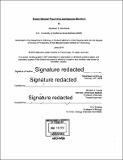| dc.contributor.advisor | Richard A. Young. | en_US |
| dc.contributor.author | Weintraub, Abraham S. (Abraham Selby) | en_US |
| dc.contributor.other | Massachusetts Institute of Technology. Department of Biology. | en_US |
| dc.date.accessioned | 2018-09-17T15:48:34Z | |
| dc.date.available | 2018-09-17T15:48:34Z | |
| dc.date.copyright | 2018 | en_US |
| dc.date.issued | 2018 | en_US |
| dc.identifier.uri | http://hdl.handle.net/1721.1/117886 | |
| dc.description | Thesis: Ph. D., Massachusetts Institute of Technology, Department of Biology, 2018. | en_US |
| dc.description | Cataloged from PDF version of thesis. Page 162 blink. | en_US |
| dc.description | Includes bibliographical references. | en_US |
| dc.description.abstract | The regulation of gene expression is fundamental to the control of cell identity, development and disease. The control of gene transcription is a major point in the regulation of gene expression. Transcription is regulated by the binding of transcription factors to DNA regulatory elements known as enhancers and promoters. This leads to the formation of a DNA loop connecting the enhancer and the promoter resulting in the subsequent transcription of the gene. Thus the structuring of the genome into DNA loops is important in the control of gene expression. This thesis will focus on the role of genome structure in transcriptional regulation. Two key questions in this area that I have attempted to address during my PhD are "how are enhancer-promoter interactions constrained so that enhancers do not operate nonspecifically?" and "are there proteins that facilitate enhancer-promoter looping?" I will describe the identification of DNA loop structures formed by CTCF and cohesin that constrain enhancer-promoter interactions. These structures-termed insulated neighborhoods-are perturbed in cancer and this perturbation results in the inappropriate activation of oncogenes. Additionally, I will describe the identification and characterization of the transcription factor YY1 as a factor that can structure enhancer-promoter loops. Through a combination of genetics, genomics, and biochemistry, my studies have helped to identify insulated neighborhood structures, shown the importance of these structures in the control of gene expression, revealed that these structures are mutated in cancer, and identified YY1 as a structural regulator of enhancer-promoter loops. I believe these studies have produced a deeper understanding of the regulatory mechanisms that connect the control of genome structure to the control of gene transcription. | en_US |
| dc.description.statementofresponsibility | by Abraham S. Weintraub. | en_US |
| dc.format.extent | 162 pages | en_US |
| dc.language.iso | eng | en_US |
| dc.publisher | Massachusetts Institute of Technology | en_US |
| dc.rights | MIT theses are protected by copyright. They may be viewed, downloaded, or printed from this source but further reproduction or distribution in any format is prohibited without written permission. | en_US |
| dc.rights.uri | http://dspace.mit.edu/handle/1721.1/7582 | en_US |
| dc.subject | Biology. | en_US |
| dc.title | Transcriptional regulation and genome structure | en_US |
| dc.type | Thesis | en_US |
| dc.description.degree | Ph. D. | en_US |
| dc.contributor.department | Massachusetts Institute of Technology. Department of Biology | |
| dc.identifier.oclc | 1051211563 | en_US |
